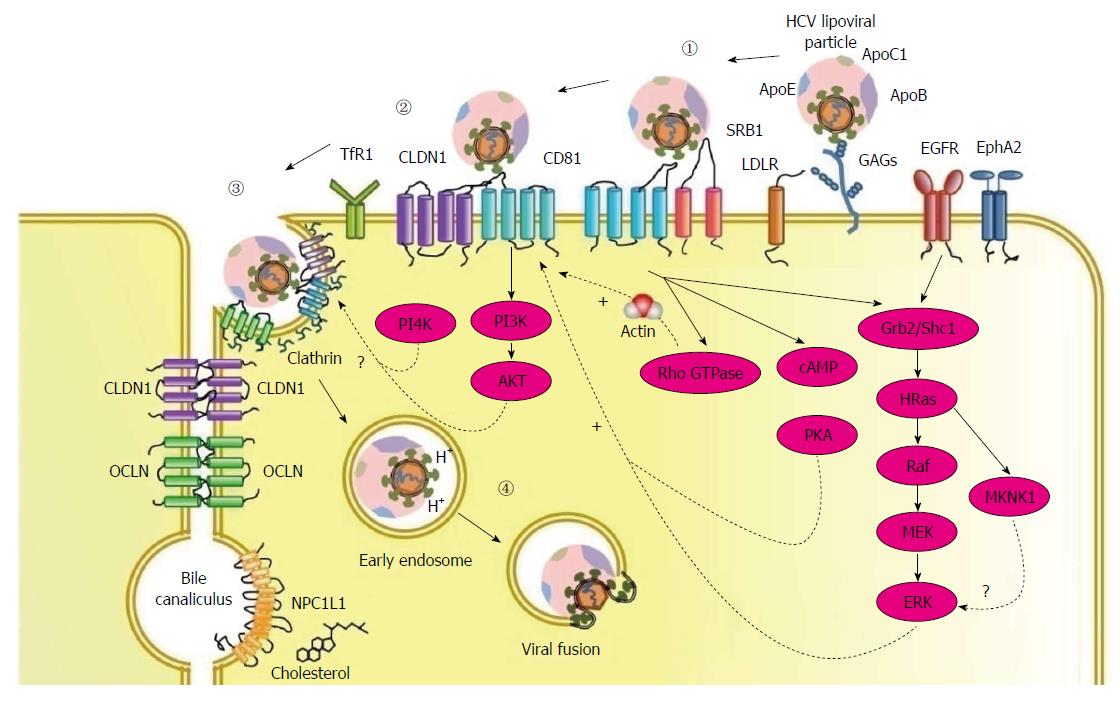Copyright
©2014 Baishideng Publishing Group Co.
World J Gastroenterol. Apr 7, 2014; 20(13): 3457-3467
Published online Apr 7, 2014. doi: 10.3748/wjg.v20.i13.3457
Published online Apr 7, 2014. doi: 10.3748/wjg.v20.i13.3457
Figure 1 Hepatitis C virus entry into hepatocytes.
① Hepatitis C virus (HCV) LVP binds to glycosaminoglycans (GAGs) and low-density lipoprotein receptor (LDLR), which have high affinity with ApoE. SRBI plays an important role in both binding and post-binding steps through interaction with virion-associated lipoprotein or HCV E2. ② Binding of SRBI to HCV particles allows exposure of CD81 binding sites on HCV E2 and transfer of the virus particles to CD81. Upon interaction with HCV E2, CD81 activates Rho GTPase family members that promote actin remodeling, thus allowing the delivery of the E2-CD81 complex to come into contact with claudin-1 (CLDN1). Two RTKs, epidermal growth factor receptor (EGFR) and EphA2 facilitate the formation of the CD81-CLDN1 complex by the EGFR-activated EGFR/Shc1/Grb2/HRas signaling pathway. The CD81-CLDN1 association is also regulated by PKA in a cAMP-dependent manner to retain CLDN1 on the plasma membrane. MKNK1 was recently identified as a host factor in HCV entry, which possibly acts to facilitate the downstream of EGFR. ③ The virion is primed by the low-pH fusion activity of CD81 and CLDN1 and translocates to the tight junctions in order to be endocytosed. Viral internalization is dependent on clathrin-mediated endocytosis. Junction protein occludin (OCLN) may contribute to this process. TfR1 plays a role in HCV infection at the level of glycoprotein-mediated entry, acts after CD81, and possibly is involved in HCV particle internalization. PI3K-AKT and PI4K pathways are engaged in the late step of HCV entry. However the mechanisms are yet to investigated. ④ Following internalization, HCV fusion occurs in the early endosomes. Low pH environment and virion-associated cholesterol are required for the fusion process. NPC1L1 may play a role in the process by cholesterol transport. After fusion between the viral envelope and an endosomal membrane, the viral genome is released into the cytosol and replication take place.
- Citation: Zhu YZ, Qian XJ, Zhao P, Qi ZT. How hepatitis C virus invades hepatocytes: The mystery of viral entry. World J Gastroenterol 2014; 20(13): 3457-3467
- URL: https://www.wjgnet.com/1007-9327/full/v20/i13/3457.htm
- DOI: https://dx.doi.org/10.3748/wjg.v20.i13.3457









